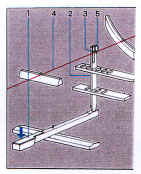The Harpsichord
- Wire strings on a wood frame plucked by tiny, sharp quills called Jacks.
- Scaled at 2/octave in upper register falling to 1.5/ocatvave in lower. Wire diameters increase from .008" to 0.024".
- No overwound strings.
- Sound is rich in harmonics and upper partials are strong, especially in the lower notes.
- See overall -6B/octave of plucked string
- See envelope of spectrum set by plucking point.
- Spectrum continues up through complete audio range, no sudden cut-off.
Harpsichord Action

Key (1) pivots on the keyrail. When the key is pressed it pushed up on the jack (2) causing the plectrum (3) to push past the string (4) makig it sound. When the key is released the jack falls back down allowing the felt damper (5) to contact the string, silencing it. The jack moves in guide holes in the jack rails and the strings are supported on bridges coupled to the soundboard.
The Piano
- Strings are hammered instead of plucked.
- Hammer stays in contact with the strings until the string vibration throws it off. This results in a much steeper fall-off of the higher partials.
- The highest notes show the steepest fall off because the hammer stays on the string longer in proportion to the period of the note.
- In addition to the generally steeper fall in frequency caused by hammering, the spectra show a clear cut-off at the high frequency end due to the damping action of the hammer.
- Especially in the lower notes see strong modulation of spectrum from stike point. Modes with nodes near the strike point are strongly suppressed.
- See non-uniform decay due to triple stringing
- See beating between the individual strings.
- See anharmonicity in the highest strings where stiffness plays the greatest role.
